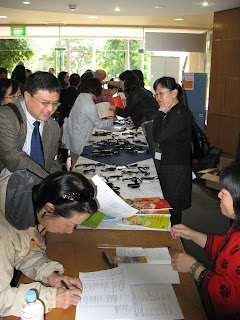

The conference has finished but the issues raised are still mulling over my head. While the number of Chinese language learners has surpassed 40 million around the world, Chinese language teaching in Australia has come to a crossroads where the direction and focus may alter due to the change in political climate caused by the “Rudd Saga”. However, in my opinion, the future of Chinese language education in this country is still dependent on the “teachers”, who are the main driving force to promote it.
From the conference, I have seen the hopes and challenges brought by ‘China Fever’ sweeping the world, including in Australia. According to Professor C. MacKerras, “China literacy” should encompass a broader knowledge of China. It includes an ability, willingness and enthusiasm to deal with its government and people. This poses a challenge for teachers who cannot see the profession beyond the realm of pure language teaching. As Professor Y. Zhao states in his DVD, “Education comes first and Chinese language comes second”. In other words, Chinese should be seen as a language that can develop students’ higher-order thinking skills, instead of being just another ‘useful’ language.
In ancient Chinese educational philosophy, there was a belief in the ideas of “教书育人”and “因材施教”, which are equivalent to the Western ideas of educating people and adopting a student-centred approach. Nevertheless, contemporary Chinese educational ideas are quite contrary to these ideals. While Dr Wang’s comments about the quality of Chinese language teachers might seem a bit harsh, there is some truth in them. Maybe that’s why Wei Ha, the president of CLTFA,was encouraging Chinese language teachers to consider the social implications associated with Chinese language teaching (社会效应) and to actively participate in the process of developing the national curriculum instead of just working hard in the confines of the classroom(不要只是埋头教书,要抬头办事).
Over the course of the conference, it was encouraging to see so many young teachers volunteering to share their ideas and experiences. I was deeply moved by their enthusiasm and passion and really appreciated their efforts. Moreover, the speeches of some keynote speakers were inspiring as well. Zhao’s presentation (DVD) confirmed some of my original ideas, such as that ‘studying culture is studying values’, ‘culture must be learned in context’ and ‘language should be used to engage other cultures’. As a migrant and a second language learner myself, I fully understand the concept of both studying values and of learning culture in context since this has been the basis of my own ‘learning experience’ in Australia. For teachers who believe in the traditional approach to teaching Chinese language and culture, this idea may be difficult to comprehend. Zhao’s points have also reminded me of the “Intercultural Language Teaching and Learning Approach”. As the newest trend in language teaching worldwide, the ILTL has dominated language education in Australia recently, especially since the release of The National Statement and Plan for Languages Education in Australian Schools 2005-2008 (MCEETYA, 2005). This entails “a fundamental shift in the orientation of language teaching and learning beyond the communicative approach of the last 20 years” (Orton, 2008a BABEL 43(1): Editorial). Hence, I hope the CLTA in all states can organise more workshops or seminars to help teachers understand this brand new approach. In this field, of course, Andrew Scrimgeour and his colleagues at the University of South Australia can definitely be of assistance.
Due to the current political uncertainty in Australia, the Digital Education Revolution may now enter a new stage. Nevertheless, as mentioned by many speakers, the use of Information and Communication Technologies (ICT) will still be extremely important in Chinese language teaching. As Professor Orton said, “Class time is limited, so teachers need to extend the learning of students by using ICT”. This is an excellent point to counter the arguments of people who believe the curriculum is too crowded and that there is insufficient time to allocate to the teaching of ICT in the classroom. Of course, I agree that ICT is only one of the many strategies to teach languages and teachers should not just rely on ICT to teach students to think, analyse, evaluate and apply their knowledge. However, faced with 21st century digital learners, teachers do need to engage them by using ICT.
According to B. Nesbitt, the writer/producer of “A vision of K-12 students today” (YouTube:http://www.youtube.com/watch?v=_A-ZVCjfWf8), while today’s young children are texting instant messages, blogging and using MSM every day, 76% of teachers have never used wikis, blogs and podcasts. Hence, there is an urgent need for teachers to become involved in this Digital Education Revolution. And that is why I think online forums, such as Hanyu laoshi Ning, set up by the Chinese Teacher Training Centre, Melbourne, is a good start. After all, this is the era of team-work. Essentially, Chinese language teachers in Australia need to communicate and share ideas more often if we are going to gain the support of politicians and the public in general.
As the theme of the conference has illustrated, teachers need to courageously scale new heights by exploring the teaching of Chinese in a pluralistic society. The conference has lifted the bar for all Chinese language teachers. For all of us, the task is to jump over it and lift the profile of Chinese language education in Australia.